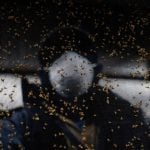The ranch we were starting from scratch had a stunning mountain view west of Grande Prairie. But except for a small lovely piece of native prairie, this was land mined hard for grain crops.
A relentless wind meant drift from the sprayer had hardened the shelterbelts to a few old stalks of saskatoon bushes. Our plan was to seed appropriate species, this time with some nutrients, and watch a grazing enterprise evolve from grain land.
Everything we did was to optimize the forage resource, build organic matter, manage natural waterways, increase wildlife populations, extend the grazing season while maintaining integrity in the landscape, and nourish the land for future generations.
Read Also

Mosquito-borne virus could be devastating to sheep breeding operations
Cache Valley virus, a mosquito-borne disease that infects small ruminants, could be a devastating hit to small operations.
We started with water — both dugout and well. The dugout was professionally done and we had the largest solar water system in Canada at the time. My daughter was instrumental in the design which allowed pumped water to flow to round tanks that could accommodate up to 500 breeding heifers.
The shelterbelts were fenced off to allow them a rest and to invite birds back into the area. The dugout was also fenced and as there were no standing cattle or winter facilities, we could safely use every square inch without run-off concerns. The real challenge was the long, cold springs, the variability in the land, and the stubborn weeds, such as horseradish, that grew in large patches.
- Part 1 in Brenda Schoepp’s three-part series: Making an old farm new again – sometimes without a playbook
At the end, the ranch had a total of 50 paddocks, one quarter section of which was temporary so it could be pulled for cleanup bulls who need space to think and for weather events such as eight inches of snow in August. This barley was the safety valve for the ranch as the seeded pasture with such heavy soil could not tolerate excessive wet. But you could trash the barley and it would simply grow back again.

There is a miracle in rest and rotation. With 50 pastures, that meant 49 were resting and that is a lot of the land in recovery at a time. We direct seeded legumes and grasses with 50 pounds of N and 25 pounds of P, using barley as a cover crop. Although using a cover crop is not preferred by some grazers, we found it a fantastic jump-start and that because of the rapid growth, the underseeded plants were not jeopardized. The long hours of sunlight allowed for several sweeps over the barley. Many grain farmers would drop by trying to find weeds in our barley fields, but we used the cattle for weeding pre-seed emergence and the fields tended to be clean.
This was the first intensive rotational grazing system in the area and so there was terrific concern about one-wire fences. But we never had an issue with the cattle going on walk about. The lifting of the fences with a white pipe to move them (no inside gates) was a positive reinforcement so we were also always in front of the cattle and not behind them. My husband and I could easily sort through 400 to 500 heifers for AI in a morning without any chasing or disruption to the cattle. Much to our working mates’ dismay, I changed the outer gate locations often as I got a feel for the land!
As for the pastures themselves, we liked to push the envelope and grow what our local friends said could not be done like corn (they were right, too close to the mountains) or orchard grass (amazing) along with combinations that would assure palatability in the field for the entire grazing season. This meant that fescue (which is harvested in the area) was grazed early in the spring and late in the fall. Relentless fellows like foxtail were grazed as soon as the snow melted. We could go back to brome continuously, but always with caution as varieties of alfalfa were mixed with the grasses to contribute to nitrogen. We did not add fertilizer after seeding as the cattle were nutrition enough with 500 head rotating on 600 acres.
Mother Nature is modest and will always try to cover herself. First with weeds and then with plants that appreciate the cooled soil. With rest and rotation, even the most stubborn of weeds disappeared. We had a minimum gain of two pounds and a maximum gain of 4.2 pounds. But on average with the barley in the mix and grazed at the shot blade, we had continuous gains of over three pounds per head per day.
The profitability on each paddock was directly related to our selection of grazing material, the palatability and the performance of it and the cattle while there. For example, our closeouts on the grazing on a per-acre basis in 2002 was $183 acre net on barley (cover crop), $63 acre net on Rangeland and Kay orchard grass, $28 acre net on traditional fescue, and $80 acre net on Fleet meadow brome. We could not make this level today, but it shows how important plant selection is.
The extreme difference in soil type, high winds, frost, and long days that ended suddenly all contributed to a steep learning curve and we discovered that what you have stored by mid-August is what you have for the rest of the year. It is about focusing on the roots and planning for extremes in the North. In the end, we had super pastures and revived shelterbelts that hummed with birds and bees. It was an amazing transformation for the land and a great time for our family.
This is the second article in a three-part series.
















